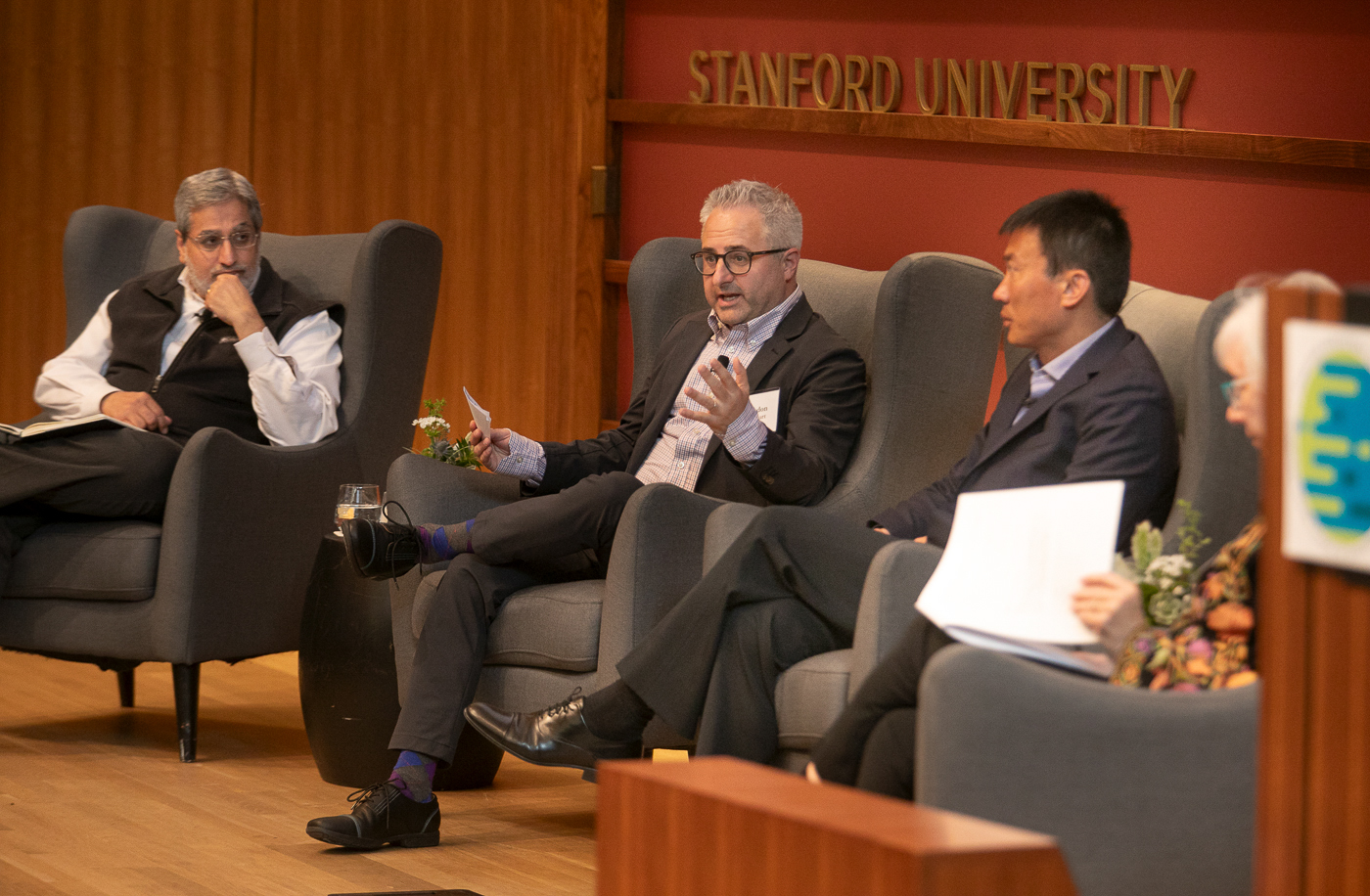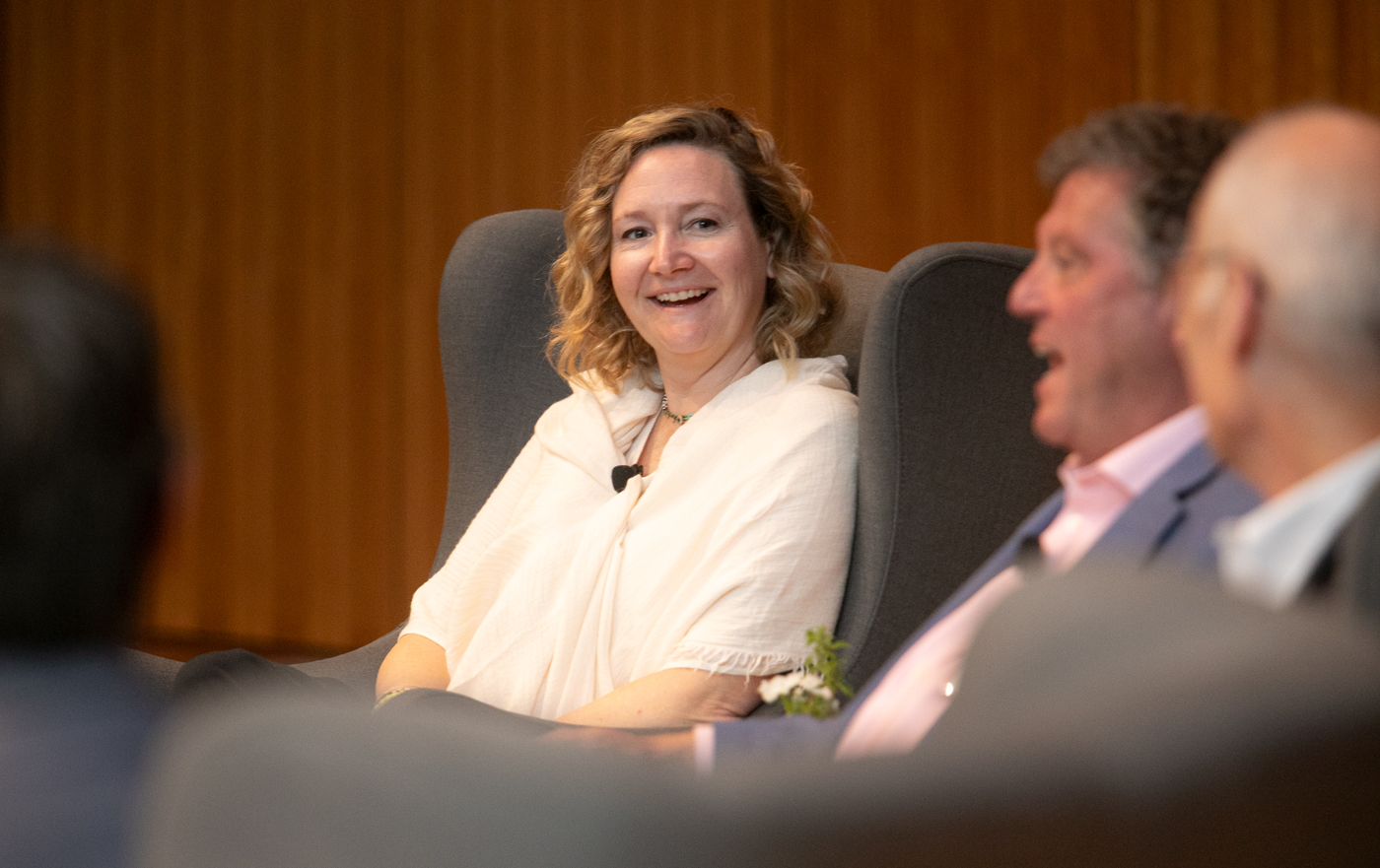How to achieve speed and scale in the clean energy transition
The Stanford Forum on the Science of Energy Transition brought together scientific experts, technology innovators, and industry leaders to explore practical pathways to a decarbonized future.

From left to right: Rajeev Ram of MIT; Brandon Hurlbut, a co-founder of Boundary Stone Partners; and Stanford’s Yi Cui and Sally Benson discuss challenges and innovations in transforming the grid. (Image credit: Saul Bromberger)
How do we transition to clean energy with enough speed and scale to prevent the most extreme impacts of climate change? This question loomed large for many of the speakers and participants at the Stanford Forum on the Science of Energy Transition, held on campus April 10 for an audience of students and invited guests.
To stabilize global temperatures, we need to find ways to reduce and remove our carbon emissions from Earth’s atmosphere by tens of gigatons every single year. By comparison, gas-powered vehicles in the U.S. together produce about a gigaton of carbon dioxide emissions each year.
Many of the speakers agreed action over the next few decades is critical, and addressing climate change will require coordinated efforts across the scientific community, climate technology innovators, government, the private sector, and others to transition the world’s $100 trillion economy to clean energy.
The forum, co-hosted by the Stanford Doerr School of Sustainability and Stanford Management Company, convened experts to explore challenges and opportunities to transform the power grid, rethink renewable fuels, remove greenhouse gases from our atmosphere, and address energy issues in tandem with other sustainability concerns.
The forum served as a powerful example of how Stanford leaders are educating changemakers in energy and facilitating connections that will help bring insights from scientific research to decisions that will affect global sustainability.
“Today, the energy transition will require us to forge new pathways, but we can’t just blindly strike out. That will lead us down too many dead ends, and time is of the essence. Instead, the paths we choose must be informed by science,” said Robert Wallace, the chief executive officer of Stanford Management Company.
Consider speed and scale from the get-go
Decarbonizing global energy production is a tall order. That’s before you consider the rising demand for energy as countries develop and look for opportunities to increase mobility, communication, security, and economic prosperity, multiple speakers said.
U.S. clean energy projects are on hold due to bottlenecks in the process for permitting new transmission lines and grid interconnections. The queue of projects waiting for approval by transmission operators would effectively triple the size of our generating resource, said Rajeev Ram, a professor of electrical engineering at MIT. Removing some of those logistical barriers through AI, modeling, and software tools can help accelerate the timeline for projects that could provide clean energy to the grid, said Ram.
Yi Cui, the director of Stanford’s Sustainability Accelerator, is one of the leading experts developing batteries for renewable energy storage. Scholars in the Stanford Doerr School of Sustainability – which celebrated its first anniversary in September – have embraced a core philosophy of thinking about scale at the beginning of the design process, which is a good sign, Cui said.
For example, the relative scarcity of some elements – such as lithium, cobalt, and nickel – in current battery designs could limit their potential for large-scale production at low cost. Cui emphasized that scientists could focus on designing battery materials based on more widely available minerals, like zinc, manganese, and iron.
“We need to figure out for each of these technologies what is already going on at the gigaton-scale – like natural cycles, like agriculture – and see what we can do to tweak it in the right way so that you can create a market and use market mechanisms to scale it,” said Arun Majumdar, the inaugural dean of the Stanford Doerr School of Sustainability.
Others highlighted the importance of driving down costs for companies and consumers. If innovators can eliminate the green premium – the cost of choosing a clean energy technology over a traditional source – for their products, they will be competitive in the market.
Meanwhile, incentives like subsidies for renewable energy will need to be supplemented with policies that actively discourage use of carbon-intensive resources. “If we’re serious about addressing climate change, we’ve got to have a price on carbon,” whether through direct pricing per ton or indirectly through regulation, said Majumdar.
Powered by electrons versus molecules
The grid is essentially a system of wires that transports electrons from power plants to consumers. However, grid electrification will only get us about halfway to reducing greenhouse gas emissions, noted Sally Benson, the Precourt Family Professor, who moderated one of the panels.
Eighty percent of global energy comes from fossil fuels. Much of this comes in the form of liquid fossil fuels for transportation – cars, planes, ships, and some trains. The challenges of developing batteries and grid storage capable of providing electricity without interruption could limit electrification of some parts of the transportation sector. Instead, renewable fuels like hydrogen, biofuels, and fuels made primarily from captured carbon dioxide may help reduce carbon emissions from heavy-duty transportation.
“Our challenge is to think that the future is electrification, but that doesn’t mean that electrons are going to do everything for us directly,” said Anthony Kovscek, the Keleen and Carlton Beal Professor in the Stanford Doerr School of Sustainability.
Hydrogen could help bridge the gap to carbon neutrality, said Eric Toone, managing director and technical lead at Breakthrough Energy Ventures.
“Hydrogen is pure, reactive chemical energy. If you have enough hydrogen, you can do anything,” he said.
Zara Summers is the chief science officer at LanzaTech, a company that makes chemicals and fuels from carbon dioxide captured from factories and other industrial sources.
LanzaTech has been working to develop ethanol alternatives that make use of carbon from municipal waste or industrial emissions. These alternatives could serve as effective drop-in replacements for liquid fuels like gasoline, with the added benefit of easy adoption by the public and ability to tap into existing supply chains, but many current economic incentives specifically benefit corn-based ethanol.
“If you’re going to go big, you have to be at cost parity or better. But, you also have to fight against policy that’s written with a solution in mind, not an outcome,” said Summers. She highlighted how designing policies that are flexible and adaptable to new innovations will help bring solutions to scale.
Science as the bedrock
In addition to the challenge of rapidly reducing greenhouse gas emissions, the forum also explored solutions for removing historic carbon emissions from the atmosphere. During a panel on greenhouse gas removal strategies, speakers turned the focus to more low-tech solutions: carbon cycles in nature. For example, Benson enthusiastically described enhanced weathering, which builds on a naturally occurring process where rain interacts with certain rocks to form a mild acid. This acid then reacts with carbon dioxide in the atmosphere to form solid compounds that permanently store carbon.
Chris Field, the director of the Stanford Woods Institute for the Environment, cited research published last month which found that adding crushed basalt rocks for enhanced weathering could increase productivity and soil health on croplands.
“It really highlights where you can potentially accomplish these big co-benefits that can make something that’s a real challenge logistically or financially come into the realm of possibility,” said Field.
The energy transition touches all of the major social-environmental systems. A final panel brought together experts on freshwater, oceans and aquatic foods, and agricultural technology to explore cultivating resilience amid climate pressures. “Agriculture sits at the very center of many of the pressures that we’re putting on Earth’s systems,” said Jim Leape, co-director of the Stanford Center for Ocean Solutions.

Arun Majumdar and Steven Chu discussed energy efficiency, nuclear fusion, national security, and more during a fireside chat. (Image credit: Saul Bromberger)
During a fireside chat, Majumdar discussed emerging trends in clean energy with Steven Chu, the William R. Kenan, Jr. Professor in the School of Humanities and Sciences. They mentioned the “low-hanging fruit” of energy efficiency, the future of nuclear fusion, and balancing the energy transition with national and economic security. Nevertheless, Chu brought the conversation back to the critical role of new inventions.
“As a physicist, when I stand back and look at things: What really changed the world? New materials are actually what changed the world,” said Chu, a former U.S. Secretary of Energy who embodies the impact of science-based decision-making in energy systems as the first scientist to hold a Cabinet position.
From the steam engine and the agricultural revolution to semiconductors and nuclear fission, leaps forward in technology have enabled global-scale changes and development. Highlighting the vision for the Stanford Doerr School of Sustainability, Majumdar noted that when research institutions like Stanford collaborate with public and private entities, they can serve as a place where scholars can serve as incubators for translating novel ideas into impact.
Yi Cui is also the Fortinet Founders Professor and a professor of materials science and engineering in the School of Engineering. He is a professor of energy science and engineering in the Stanford Doerr School of Sustainability, a professor, by courtesy, of chemistry in the School of Humanities and Sciences, and a professor in the Photon Science Directorate. Cui is also a senior fellow at the Precourt Institute for Energy, and the institute’s immediate past director, and a senior fellow at the Stanford Woods Institute for the Environment.
Arun Majumdar is the Chester Naramore Dean of the Stanford Doerr School of Sustainability, the Jay Precourt Provostial Chair Professor, and a senior fellow at the Precourt Institute for Energy. He is also a professor of mechanical engineering and, by courtesy, of materials science and engineering in the School of Engineering, and a professor in the Photon Science Directorate. He is a senior fellow, by courtesy, at the Hoover Institution.
Sally Benson is the Precourt Family Professor in the Stanford Doerr School of Sustainability, where she is a professor of energy science and engineering; a senior fellow at the Precourt Institute for Energy; and a senior fellow at the Woods Institute.
Anthony Kovcsek is a professor of energy science and engineering, and a senior fellow at the Precourt Institute for Energy.
Chris Field is also the Melvin and Joan Lane Professor in Interdisciplinary Environmental Studies in the School of Humanities and Sciences; the Perry L. McCarty Director of the Woods Institute; a professor of Earth system science in the Stanford Doerr School of Sustainability; and a senior fellow at the Precourt Institute for Energy.
Jim Leape is the William and Eva Price Senior Fellow at the Woods Institute and a professor, by courtesy, of oceans.
Steven Chu is a Nobel laureate and a professor of energy science and engineering in the Stanford Doerr School of Sustainability. He is also a professor of molecular and cellular physiology at Stanford Medicine and of physics in the School of Humanities and Sciences.
